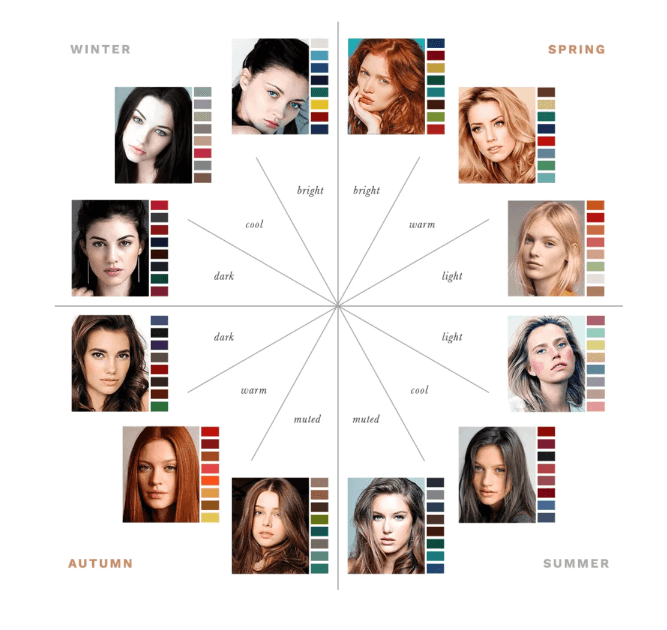Have you ever noticed how certain clothing colors seem to light up your face, making you feel more vibrant and confident? It's not just your imagination – there's a science behind it. Welcome to the world of color theory, where understanding the intricacies of hue, value, and chroma can transform the way you dress and present yourself to the world.
At Wendi's Good Things Market, we believe that embracing color theory can revolutionize your style and boost your confidence. Take, for example, my own recent photo. On one side I am wearing neutral tones, and on another, I am wearing cool winter tones (my season). The difference is striking – my features seem to come alive in the cooler hues, highlighting my eyes and skin tone in a way that the neutral tones simply can't match.
What is Color Season Analysis?
This exciting method allows us to uncover the most flattering colors for a person's features. We do this by examining three specific features: eye color, skin tone and hair color. These days there are professionals whose entire careers are devoted to helping you determine your colors. There are even apps you can download. However, it shouldn’t be that difficult anymore. We should be able to get pretty close right here.
Why Is Understanding Color Seasons Important?
Let’s just say this isn’t a life or death situation here, so it isn’t a level 10 in importance, but it can save you a lot of headaches. We often see others in things or fill our closets with clothing that just doesn’t quite look that great on us. It would be GREAT to spend our time and money on things that really bring out our best selves.
Here’s the benefits of what know your season can do for you:
-
You’ll look better. Not only does the right color help you glow, you will look youthful and vibrant.
-
Looking your best gives you more confidence.
-
Where the right colors will make you look more put together and even more upscale / elevated.
-
This also saves time…no more wasting time on colors that don’t suit you. You’ll just automatically walk right past things that don’t work for you.
Here’s a quick chart of the 4 seasons, the undertones and the best colors the skin tone.
Just as nature transitions from fresh spring greens to gentle summer hues, earthy autumn tones, and icy winter shades, our wardrobes can evolve to reflect these shifts in color and light. Carole Jackson's groundbreaking book, "Color Me Beautiful," introduced the concept of identifying one's "season" based on personal coloring and undertones. While the original four seasons – Spring, Summer, Autumn, and Winter – provided a starting point, it became clear that not everyone fit neatly into these categories. Thus, the concept of twelve seasons was born, allowing for greater nuance and precision in color analysis.

Now let's dig in deeper to each one. Go the the season you feel you are most close to and see the differences between each type. Pay close attention to hair, skin, and eye color. Write down which fits you the most. Try not to overthink this.
1. Soft Summer
Soft summers have muted and cool-toned features. Their color palette consists of subdued shades such as soft blues, lilacs, and greys.
2. Cool Summer
Cool summers also have cool-toned features but with more contrast. Their color palette includes cool and vibrant shades such as periwinkle blue and cool pinks.
3. Light Summer
Light summers have pale and cool-toned features. Their color palette comprises soft and delicate shades like pastel yellows, pinks, and blues.
4. Bright Spring
Bright springs have warm and bright features. Their color palette is filled with vibrant and energetic shades like sunny yellows, coral, and lime green.
5. True Spring
True springs also have warm and bright features. Their color palette features warm and sunny shades such as gold, peach, and aqua.
6. Light Spring
Light springs have light and warm features. Their color palette includes light and airy shades like pastel blues, pinks, and yellows.
7. Soft Autumn
Soft autumns have warm and muted features. Their color palette includes soft and earthy shades like olive green, mustard yellow, and mauve.
8. True Autumn
True autumns have warm and rich features. Their color palette features rich and earthy shades such as burnt orange, deep red, and olive green.
9. Dark Autumn
Dark autumns have deep and warm features. Their color palette comprises dark and intense shades like chocolate brown, deep burgundy, and forest green.
10. Dark Winter
Dark winters have cool and deep features. Their color palette includes bold and dramatic shades like royal blue, emerald green, and deep purple.
11. True Winter
True winters have cool and intense features. Their color palette consists of clear and vivid shades like true red, bright fuchsia, and royal blue.
12. Bright Winter
Bright winters have cool and bright features. Their color palette features striking and vibrant shades like electric blue, hot pink, and emerald green.
Understanding your seasonal color palette can revolutionize your approach to fashion and personal style. By embracing the hues that harmonize with your natural coloring, you can create effortlessly chic looks that accentuate your best features and make you feel confident and empowered. Whether you're a radiant Spring, a serene Summer, a vibrant Autumn, or a striking Winter, there's a palette perfectly tailored to enhance your beauty and express your unique personality.
At Wendi's Good Things Market, we LOVE hearing how our work impacts you! Email us at hello@wendismarket.com
and tell us what you've learned about yourself! We can't wait to hear from you! xo, Wendi
















